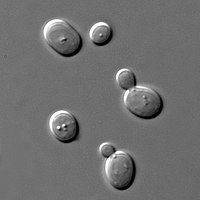
Photo from wikipedia
The budding yeast S. cerevisiae is a powerful model to understand the multiple layers of control driving an asymmetric cell division. In budding yeast, asymmetric targeting of the spindle poles… Click to show full abstract
The budding yeast S. cerevisiae is a powerful model to understand the multiple layers of control driving an asymmetric cell division. In budding yeast, asymmetric targeting of the spindle poles to the mother and bud cell compartments respectively orients the mitotic spindle along the mother-bud axis. This program exploits an intrinsic functional asymmetry arising from the age distinction between the spindle poles-one inherited from the preceding division and the other newly assembled. Extrinsic mechanisms convert this age distinction into differential fate. Execution of this program couples spindle orientation with the segregation of the older spindle pole to the bud. Remarkably, similar stereotyped patterns of inheritance occur in self-renewing stem cell divisions underscoring the general importance of studying spindle polarity and differential fate in yeast. Here, we review the mechanisms accounting for this pivotal interplay between intrinsic and extrinsic asymmetries that translate spindle pole age into differential fate.
Journal Title: Results and problems in cell differentiation
Year Published: 2017
Link to full text (if available)
Share on Social Media: Sign Up to like & get
recommendations!